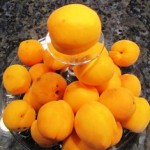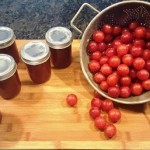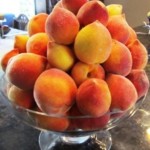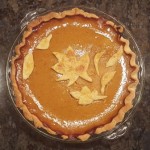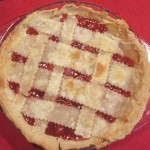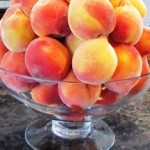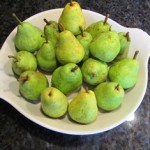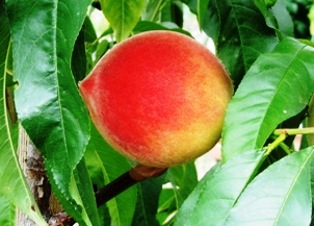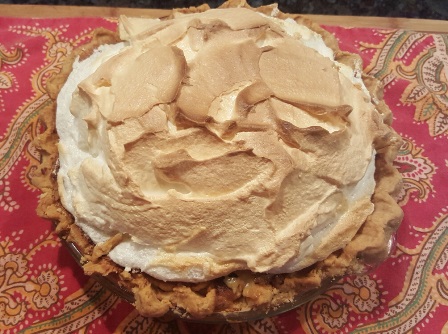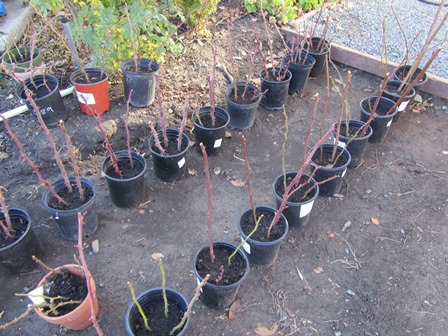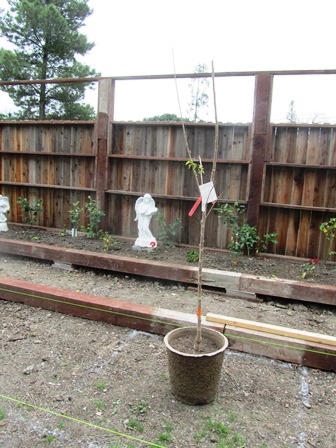Country Fresh Peach Cobbler
Ripe peaches, widely available throughout summer, are delicious in cobblers, pies, and pancakes. They are scrumptious in spreads like jam for toast, on pound cake drizzled in brand or a fruit wine, or over warm bread. Alternatively, pile ripe peaches into a pandowdy, tart, galette, or crostini (the French and Italian versions of a rustic one-crust pie with edges folded over to hold in the fruit).
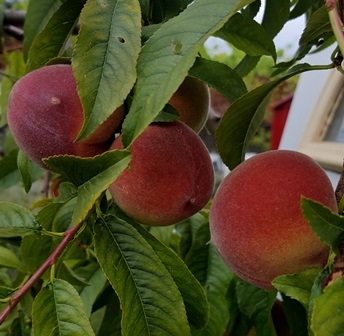
Folks in the Midwest where I grew up enjoy peach cobbler best when served warm with rich vanilla ice cream or piled high with homemade whipped cream. Of course, this cobbler is especially tasty served cold when flavors have time to marinate. To ensure freshness, always refrigerate.
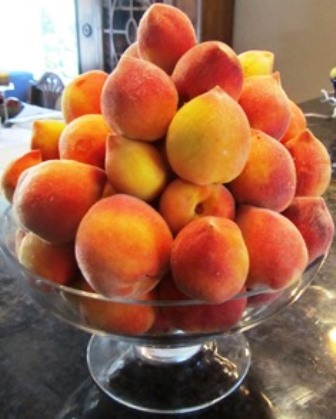
For this peach cobbler recipe, you’ll need about two and one-half pounds of fresh, ripe peaches. Gather your tools, bowls, and ingredients. Preheat the oven to 350 degrees Fahrenheit.

RECIPE: COUNTRY FRESH PEACH COBBLER
Ingredients:
1 cup flour
2 teaspoons baking powder
1/2 cup sugar
6 Tablespoons cold, unsalted butter, cut into cubes
1 large egg, lightly beaten
1/4 cup Half & Half
2 1/2 pounds fresh peaches (peeled, pitted, and sliced)
2 Tablespoons fresh lemon juice
2 Tablespoons apricot preserves
1 teaspoon ground nutmeg or mace and 1/2 teaspoon ground cinnamon for peach filling
1/2 teaspoon ground cinnamon mixed with 2 Tablespoons sugar for topping
Directions to Make Crust
Divide sugar into two equal portions. In a large bowl, pour in the flour, baking powder, and one portion of the sugar. Mix the ingredients until thoroughly combined. Cut four tablespoons of the butter into cubes. Drop pieces of butter into the dry ingredients. Using a pastry cutter or your fingers, integrate the butter into the dry ingredients until the mixture is crumbly. In a separate bowl, beat together egg and Half & Half. Slowly pour this into the dry flour mixture and mix until the dough is moistened, not wet. On a piece of plastic wrap that has been sprinkled with a little sifted flour, shape the dough into a ball, cover with plastic wrap, and refrigerate for 15 minutes.
Directions for Preparing the Peaches
In a medium-size bowl, mix the peeled, pitted, and sliced peaches with lemon juice, nutmeg (or mace), 1/2 teaspoon cinnamon, apricot preserves, and the remaining portion of sugar. In a 1 1/2 quart baking dish, pour in the peach filling. Cut the remaining butter into pieces and add to the peaches.
Directions for Assembling the Cobbler.
Roll out the cobbler dough and place it so that it covers the peaches and stretches to the edge of the baking dish. Seal by crimping the dough around the edges of the dish. Cut vents into the dough. Then sprinkle the cinnamon and sugar mixture over the top of the crust. Bake 30 to 35 minutes. Remove when crust has browned and let cool. Serve with ice cream or whipped cream.
If you enjoy reading about country living, check out the novels based on my farmette life: A Beeline to Murder, The Murder of a Queen Bee, and A Hive of Homicides. All are available from Amazon, Barnes & Noble, and other online retailers as well as bookstores everywhere.

Late to Ripen But Oh, So Yummy!
Following the historic long seasonal deluge of rain, our fruit trees are loaded with peaches, apricots, plums (the cherries are gone now). While there is plenty of stone fruit, it’s all ripening late this year.
Our Blenheim apricots were ready to pick, dry, and make into jam in late May of 2018. On this last day in June, I plucked an apricot that was ripe on the side facing the sun but the opposite side was green and hard.
The cherries, too, ripened late this year. We picked about 8 gallons of cherries from our two Bing and Stella trees. I dried some and we gave away a lot.
The Black Tartarian cherries didn’t produce as heavily this year as last. By the time we discovered the ripe cherries, the birds had already beaten us to the super-sweet fruit. I don’t mind sharing with the local wildlife, but would have loved a bowl of these for snacking.
The yellow and red plums are finally ripe now. Today, I’m making plum jam. Nothing beats hot toast with spreadable summer jams and marmalade for breakfast on a winter’s day. In a normal year, most of my jam-making of stone fruits would be finished by now.
The early Desert Gold peaches are gone now, a tasty memory, from a month ago. However, we still have summer peaches clinging to the tree. I check them daily. Fresh peach pie for the fourth of July is a favorite at my house.
While the fruits and berries seem to ripen more slowly this year, my vegetable garden is blowing my mind. I have several raised beds in a fenced-off area so wild animals won’t bother it. Most of the raised beds were used for composting (think, tons of chicken manure, yard clippings, and cardboard). Still, I added other organic amendments. Boy, is that soil paying off.
It’s a banner year for vegetables on the farmette. Most will be eaten fresh but the sugar pumpkins won’t ripen until autumn. Love them in pie.
_____________________________________________________________________________________
I’ve been told I’m living a “charmed life” on my Henny Penny Farmette. And so it is. But this chapter of my life didn’t happen by accident. I once lived in Silicon Valley and was part of life in the fast lane, which I enjoyed. But I grew up on a farm. I missed time in nature, eating foods that I knew were healthy and wholesome and pesticide-free, and the slower pace of life. I set an intention to manifest the life I have now. You can, too.
FIND ME ALSO at Meera-lester.com (don’t forget that hyphen…very important.)
If you enjoy reading about gardening, keeping chicken and bees, and other farm topics, pick up copies of my Henny Penny Farmette series of cozy mysteries. The books are chocked full of farm and craft trivia as well as delicious recipes and, of course, intriguing mysteries.
Swimming in Fruit
Our cherry trees became so heavily laden with fruit this year I couldn’t work fast enough to make the fruit into cookies and pies and jars of jam, conserve, and chutney.
What fruit the birds and squirrels didn’t devour ended up drying on the trees and looking like ornaments. I’m heartened that at least the wildlife will have something to forage on through fall and winter.
The apricot trees did a massive drop of their fruit and seemingly all at once. I made more jam than we’ll probably eat, dried some, and gave away more than a few full buckets of cots to neighbors and friends. I also had to do a messy cleanup of fruit on the ground.
In the cycle now are the summer peaches; so, here I go again . . swimming in fruit.
Next year, I’m going to get my act together early with teams of backyard pickers who can help me remove the fruit, divide it, and distribute it. Right now, however, I’ve got peaches to pick and preserve. The summer pears and figs will be next.
I’m not complaining; I’m enthralled that all this bounty is due to the work of our industrious little honeybees. All this fruit and I haven’t even mentioned finding time to harvest honey. Yet, the bees don’t stop, so neither will I.
________________________________________________________________
If you enjoy reading about farmette topics like keeping bees and chickens, caring for an orchard, or growing heirloom herbs and vegetables, check out my mystery series from Kensington Publishing (due out September 26, 2017).
These novels feature a whodunnit for you to solve and are filled with farming facts, trivia, and delicious recipes. The novels and my other books are available in traditional and online bookstores everywhere. See, http://tinyurl.com/yb42zd2d
How to Grow a Fruit Tree from a Pit
Nothing beats a breakfast of summer fruit picked fresh from a patio or backyard tree. I’m referring to fruit trees such as apricots, peaches, and nectarines. Cherries and plums are also among my favorites. The fruit from these trees is often referred to as stone fruit because of the hard pits (holding the seed) around which the fruit forms.
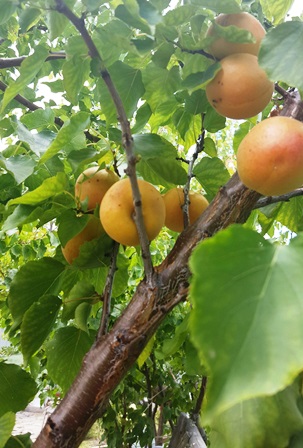
By mid-May, ripe apricots hanging on the trees in my backyard don’t last long–they’re eaten fresh, made into jams, and dried
Apricots in the Bay Area ripen in mid-May and peaches often ripen a bit later during the three months of summer (depending on the cultivar). If you love eating the fruit, don’t toss the pits. Consider that an apricot or peach grafted onto rootstock might cost upwards of $20 during bare-root season but $35 to $50 if sold in a pot. Growing from seed costs nothing.
Planting the seed extracted from the pit of your favorite apricot or peach variety can generate a tree with a very good chance of carrying the parent trees’ traits and producing fruit within three to five years. In fact, I’ve found that pits of my apricot, cherry, wild plum, peach, and nectarines that are left on the ground or discarded by the squirrels who’ve eaten the fruit will often sprout on their own.
Use this ten-step method to grow a peach or apricot tree from seed.
1. Choose a pit from a locally grown ripe fruit that tastes juicy and delicious.
2. Dry the seed on a paper towel in your kitchen window for several days.
3. Carefully crack open the hard shell of the pit to reveal the seed inside (it will resemble an almond).
4. Put the seed (or several seeds) in a sealed container in your refrigerator and let it chill for up to three months. The cool temperature exposure helps the seed get ready to sprout.
5. Time your removal of the seed from the refrigerator to a month before the last frost date in your area.
6. Cover the seed in water overnight and in the morning plant it a clear glass jar of potting soil (no lid on the jar).
7. Return the jar to the refrigerator and keep the seed moist until it has sprouted (about one month).
8. When the outside weather conditions are right (no more frost and the soil begins to warm), plant the seedling in your garden in fertile, well-drained soil.
9. Dig a basin around the planting hole for watering.
10. Mulch to keep down weeds and ensure the roots stay cool. In three years, watch for blossoms in the spring with fruit to follow.
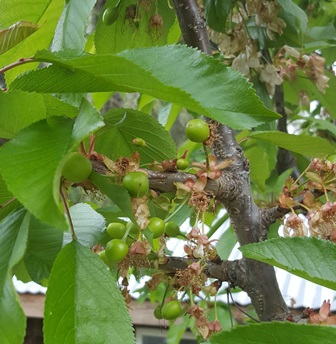
Cherry pits are much smaller than other stone fruit; pits of sour cherries (and also wild plums) may self-seed but sweet cherries less so. Cherries must have a period of cold to germinate
* * *
If you enjoy farmette topics like gardening heirloom vegetables, herbs, and fruits as well as keeping chickens and bees, check out my Henny Penny Farmette series of cozy mysteries from Kensington Publishing–A Beeline to Murder, The Murder of a Queen Bee, and A Hive of Homicides.
You’ll find in the Henny Penny Farmette series
-
Delicious recipes
-
Farm quips and quotes
-
Tips for gardening and keeping chickens and bees
-
An exciting whodunnit mystery
Also, check out MY POCKET MEDITATIONS, my newest forthcoming nonfiction title from Adams Media/Simon & Schuster, at http://tinyurl.com/l6lzorq
![My Pocket Meditations: Anytime Exercises for Peace, Clarity, and Focus by [Lester, Meera]](https://images-na.ssl-images-amazon.com/images/I/51GH%2BXEPc6L.jpg)
Great Pie Begins with a Buttery, Flaky Crust
My stalwart Scots-Irish grandmother was thrifty and talented when it came to food preparation. She made delicious pies from cherry, rhubarb, peaches, apples, pears, and sweet berries of every kind, including gooseberries. Her pies were my childhood delight when I lived with her and my grandfather on their Boone County, Missouri farm.
She made delicious meat pies from meats she’d preserved by canning. Missouri winters could be harsh. Those meat pies nourished me when the snow piled up outside the windows, and it was too cold to make a trek to the smoke house where her prized Boone County hams hung from hooks.
Sometimes, my grandmother combined fruits or berries in a rustic pie (today, we call it a galette) and on other occasions, she made a raisin, pecan, pumpkin, coconut, or a custard pie. And meringue, if used, was high and sweet and just the right shade of golden brown. But it was the pie crust that I loved.
For the top of a peach pie, she’d cut in a large curve shaped like a branch. Then two or three other lines would curve from it. Lastly, she cut teardrop shapes along the arch lines so the top crust art would suggest a peach tree branch. When she worked crisscross strips atop a cherry pie, it was both beautiful and delicious.
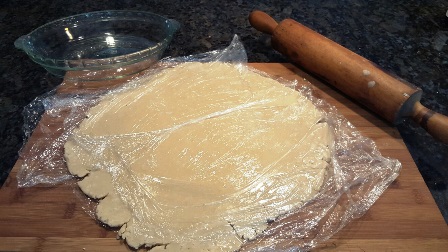
Storing or rolling the crust between sheets of plastic wraps is a good way to avoid handling the crust with your hands.
The secret to her buttery, flaky crust was not to handle it too much. Today, I make the same recipe but in my food processor. Like her, I use chilled or ice water, adding only drops at at time as the food processor is pulsing the dough–only enough to get the dough clinging together. The point is to move the dough from dry and crumbly to clumping into a ball.
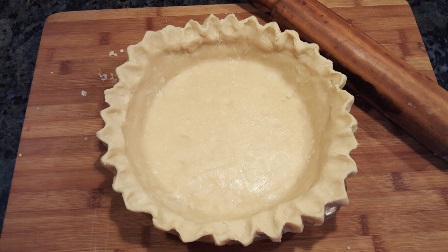
This fluted crust is ready for almost any kind of filling. I will prick the bottom and sides with a fork before filling and baking.
After the dough is made, I dump it from the food processor bowl onto aluminum foil or plastic wrap and work it into a ball (without touching it). The dough goes into the fridge for a chill over an hour and up to 24 hours. The recipe makes enough for a pie top and bottom or a couple of pies requiring only the bottom crust.
Ingredients:
2 1/2 cups flour
1/2 teaspoon salt
1 teaspoon granulated sugar
1 cup chilled unsalted butter, cut into pieces
1/4 (plus a few tablespoons more if necessary) cold or ice water
Directions:
Add the dry ingredients (flour, salt, and sugar) in the food processor bowl.
Cut the butter into small chunks and drop the pieces in. Pulse into a crumbly, dry meal.
Add ice water to the mixture in the bowl by dropping spoonfuls through the feeding tube and pulsing after each addition.
Remove the dough when it clings together–neither too wet nor too dry–by dumping it out on a large sheet of aluminum foil or plastic wrap.
Mold the dough into a ball and flatten into a thick disk to make it easier to roll out.
Chill for an hour or up to 24 hours.
Makes two buttery, flaky crusts.
* * *
If you enjoy reading about farmette topics (including gardening, beekeeping, and delicious recipes), check out my cozy mysteries A BEELINE TO MURDER and also THE MURDER OF A QUEEN BEE in the Henny Penny Farmette series (from Kensington Publishing).
These novels are available through online retailers such as Amazon, Barnes & Noble, Kobo Books, and Walmart as well as from traditional bookstores everywhere.
See, http://tinyurl.com/hxy3s8q
Now available in mass market paperback, this debut novel launched the Henny Penny Farmette series of mysteries and sold out its first press run.
See, http://tinyurl.com/h4kou4g
The second cozy mystery in the Henny Penny Farmette series, available Sept. 27, 2016, is now available on Net Galley (netgalley.com) for professionals and readers who write reviews.
Pruning between Storms
The roses, fruit trees, vines, and bushes need pruning, I’ve been itching to get to them, but it’s been raining. Storms have been moving through but with breaks. With rain predicted well into February and March, I don’t think it’s a good idea to put off the pruning. Warm weather will start everything sprouting.
A Level 2 storm moved through today with high winds and rain. I waited until almost lunch time before venturing out. The winds are still fierce, but there are patches of blue in the sky. I filled pots with soil, took cuttings of my roses, dipped them into root hormone, and inserted several in each pot. These will become new bushes for the flower gardens out front of the house.
I love this time of year when the stack of seed catalogs grows daily and nurseries are gearing up for the bare-root season. Already my family is asking when can we plant spring peas, pointing out that the onions and garlic are up and the rhubarb root has set up new leaves.
I did a walk around recently and noticed that with all the rain and warm temperatures, my Desert Gold peach trees and the Bing and Black Tartarian cherries are covered with buds. The buds are swelling but no blossoms yet.
Grass and weeds are up nearly eight inches and growing like crazy. My lavender and the earliest bulbs are blooming. All this lovely growth seems weird after four long years of intense drought.
Even songbirds and honeybees seem happy as they flit around the farmette between the storms. Surely, these signs are harbingers for the glorious spring to come. All the more reason to get busy pruning between these storms.
Backyard Fruit Compote
Who feels like eating when the shorts and sandals weather has turned hot enough to warrant wearing bikini bottoms and thin cotton T-shirt for doing your household chores? Bring on the cool summer salads.
When the temperatures hit 105 on the farmette yesterday, we opted for a simple supper of cold chicken, orzo with Italian vinegar and oil dressing, and cold potato salad.
With nectarines and peaches ripening now on our trees, blueberries finally sweet enough to eat, and strawberries available at our local farmers’ market, what could be better for a dessert on a hot summer’s evening than a fruit compote.
Recipe for Backyard Fruit Compote
Gather the fruit, including nectarines, peaches, plums, strawberries, blueberries, kiwi, and melon.
Wash, and slice the nectarines, peaches, plums, and strawberries.
If including melon in the compote, scoop the melon into ball shapes using a melon baller or cut pieces of melon into cubes.
Peel and slice the kiwi.
Toss all into a bowl, adding the blueberries.
Sprinkle lightly with a scented sugar, or a super fine sugar, or honey.
Or, make a dressing: mix together 1/4 cup of lime juice, 1/4 cup of honey, 1 teaspoon of orange zest, 1 teaspoon of lime zest, and 1/2 teaspoon finely grated ginger. Pour over the fruit. Chill for about 1 hour and add springs of mint before serving.
Drying Fruits Naturally
I love dried apricots, but don’t tolerate well the ones treated with sulfur dioxide(used to prevent oxidation and loss of color). With so many apricots on our property coming ripe at once, I have decided in addition to making jam this year to also dry some of the fruit.
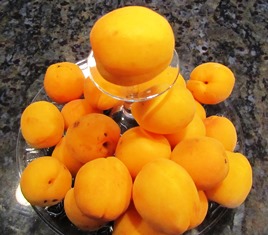
Apricots, so plentiful this time of year, are easy to dry and make great snacks when the season is over
Apricots dried but not treated with sulfur dioxide will turn a natural brown color. Some stores sell them this way. They are usually priced the same or similar to the treated apricots with the bright orange hue.
Besides apricots, other fruits that dry well include apples, bananas, cherries, grapes, nectarines, peaches, pears, plum, rhubarb, and even strawberries. You can use a drying machine
Quick Tips for Drying Fruit
1. Choose to dry only the freshest picked fruits, without bruises, scale, sun scald, or other blight.
2. Spray nonstick vegetable spray on drying pans or trays to make it easier to remove the dried fruit
3. Lay out the fruit to dry in a single layer on trays. Remember to rotate the trays occasionally and turn the pieces from time to time.
4. Destroy any insects (miniscule or otherwise) by freezing or baking the fruit. Simply take the tray and stick it into an oven heated to 175 degrees Fahrenheit for about 15 minutes. Alternatively, pack the dried fruit in freezer bags and freeze for at least 2 days.
5. Freezing dried fruit in resealable freezer bags will preserve its shelf life.
Peaches Add Flavor to a Slow-Sippping Summer Drink

Desert Gold is an early ripening peach cultivar that grows well in the southwest and in western gardens
Summer remains weeks away but already the Northern California farmers’ markets are in full swing, selling apricots, cherries, strawberries, and early-ripening peaches. The early peaches I grow on the farmette are Desert Gold.
Peaches taste great eaten fresh, prepared in cobblers, and added to homemade ice cream. But you can also use fresh peaches to make a lovely, slow-sipping brandy-and-wine drink.
Eau de vie is French for “water of life.” Basically, it is a brandy made of fruit with no added sweetener and not aged. It is best consumed chilled and sipped after a meal as a dessert or digestive drink.
Making your own eau de vie is fairly straightforward and you’ll find many easy recipes. Don’t be afraid to experiment with fruit flavors. Basically, just add prepared fruit to pure grain alcohol and then distill it. Or, mash fresh fruit, ferment, and distill it. Here’s an easy recipe for a summer drink that combines purchased eau de vie with white wine and peaches.
PEACHY SUMMER SIPPER RECIPE
Ingredients:
6 ripe peaches
4 cups dry white wine
1 cup superfine sugar
1/4 cup Eau de Vie (brandy made of fruits)
Directions:
Skin the peaches and slice each peach in half.
Pour the wine into a stainless steel pan.
Gently simmer the fruit in the white wine until tender (about 15 minutes).
Cover the fruit and let stand overnight to impart its full flavor to the wine.
Remove the peaches from the wine.
Strain the wine through a fine sieve or paper filter.
Add the eau de vie to the peach-flavored wine.
Add the sugar and stir well to dissolve.
Pour the blended beverage into sterilized dry bottles and cap or cork.
Keep refrigerated. Use within two weeks.
The Start of Something Wonderful . . . Spring!
I jumped at the chance to visit my favorite nursery this past weekend after my husband suggested a drive to Livermore, California. Alden Lane Nursery occupies a beautiful setting amid ancient oaks and there is even a honeybee hive on the premises. Wisteria blooms in perfusion there this time of year.
We came away with some pepper plants, two smoke trees, and four cherry trees, including Bing and Black Tartarian, its pollinator.
We are going to plant the cherry trees at the front of our property and the smoke trees will go in that area as well. We’ve done very little landscaping on the front of our land, preferring to get the trees and gardens in at the back near our hives and chicken run.

The beds that run the length of the fencing at the front of the farmette feature statuary, citrus, and bedding plants
Everywhere you look on the farmette, there are projects to be done. We chip away at them when we can. My husband works days and I write my novels, so the work will undoubtedly be never-ending. But that’s okay. We aren’t in a hurry and it’s easier to just live by the cycles and seasons of nature.
When I think of how the peaches and apricots are forming and the bees are almost ready to swarm, I know spring is here. And it’s my favorite season, so I’ll go outside, ignore the projects, have a cup of tea, and enjoy the start of something wonderful!
 Facebook
Facebook Goodreads
Goodreads LinkedIn
LinkedIn Meera Lester
Meera Lester Twitter
Twitter



